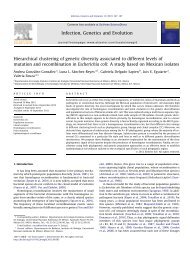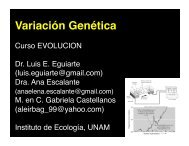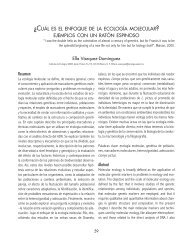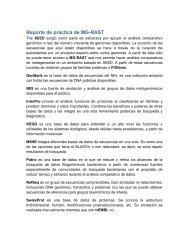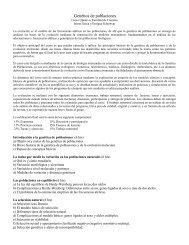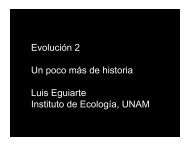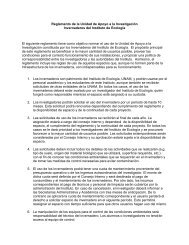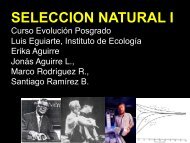Capitulo 11 Plantas - Instituto de Ecología - UNAM
Capitulo 11 Plantas - Instituto de Ecología - UNAM
Capitulo 11 Plantas - Instituto de Ecología - UNAM
You also want an ePaper? Increase the reach of your titles
YUMPU automatically turns print PDFs into web optimized ePapers that Google loves.
252DIVERSIDAD BIOLÓGICA DE SONORAPloidy Race Distributions Since the Last GlacialMaximum inthe North American Desert Shrub,Larrea tri<strong>de</strong>ntata. Global Ecology and Biogeography10: 521-533.JOHNSTON, I.M. 1924. Expedition of the California Aca<strong>de</strong>myof Sciences to the Gulf of California in 1921:the Botany (vascular plants). Proceedings of the CaliforniaAca<strong>de</strong>my of Sciences, series 4, 12: 951 1218.KEARNEY, T.H. y R.H. PEEBLES. 1964. Arizona Flora.University of California, Berkeley, California.LENZ, L.W. 1986. Marcus E. Jones: Western Geologist,Mining Engineer and Botanist. Rancho Santa AnaBotanic Gar<strong>de</strong>n, Claremont, California.LEOPOLD, E.B., G. LIU y S. CLAY-POOLE. 1992. Low-Biomass Vegetation in the Oligocene. En. D.R.Prothero y W.A. Berggren, eds. Eocene-OligoceneClimatic and Biotic Evolution. Princeton UniversityPress, Princeton, Nueva Jersey, pp. 399-420.LUMHOLTZ, C.S. 1902. Unknown Mexico: A Record ofFive Years’ Exploration among the Tribes of the WesternSierra Madre; in the Tierra Caliente of Tepic andJalisco; and among the Tarascos of Michoacán. CharlesScribner’s Sons, Nueva York.LUMHOLTZ, C.S. 1912. New Trails in Mexico. Scribner,Nueva York.MALDONADO, J.L. y M.A. PUIG-SAMPER. 2000. La aventuraultramarina <strong>de</strong> Sessé y Mociño. La real expediciónbotánica a Nueva España (1787-1803) En:M.P. San Pío Alar<strong>de</strong>en y M.A. Puig-Samper, eds.El águila y el nopal. La expedición <strong>de</strong> Sessé y Mociñoa Nueva España (1787-1803) Lunwerg, Barcelona,pp. 35-52.MARSHALL, J.T., JR. 1957. Birds of the Pine-Oak Woodlandin Southern Arizona and Adjacent Mexico.Cooper Ornithological Society, Pacific Coast Avifauna32: 1-125.MARTIN, P.S., D. YETMAN, M. FISHBEIN, P. JENKINS, T.R.VAN DEVENDER y R.K. WILSON. 1998. Gentry’s RioMayo Plants. The Tropical Deciduous Forest and Environsof Northwest Mexico. University of ArizonaPress, Tucsón, Arizona.MCLAUGHLIN, S.P. 1989. Natural Floristic Areas of theWestern United States. Journal of Biogeography 16:239-248.MCLAUGHLIN, S.P. 1992. Are Floristic Areas HierarchicallyArranged? Journal Biogeography 19: 21 32.MCLAUGHLIN, S.P. 1995. An Overview of the Flora ofthe Sky Islands, Southeastern Arizona: Diversity,Affinities, and Insularity. En: L.F. DeBano, P.F. Ffolliott,A. Ortega Rubio, G.J. Gottfried, R.H. Hamrey C.B. Edminster (coords.) Biodiversity andManagement of the Madrean Archipelago: The skyIslands of Southwestern United States and NorthwesternMexico. USDA Forest Service, General TechnicalReport, RM GTR 264, pp. 60-70.MCVAUGH, R. 1956. Edward Palmer, Plant Explorer ofthe American West. University of Oklahoma Press,Norman, Oklahoma.MCVAUGH, R. 2000. Botanical Results of the Sessé andMociño Expedition (1787-1803). VII. A Gui<strong>de</strong> to RelevantScientific Names of Plants. Hunt Institute forBotanical Documentation, Carnegie Mellon University,Pittsburgh, Pensilvania.MEARNS, E.A. 1907. Mammals of the Mexican Boundaryof the United States. A Descriptive Catalogueof the Species of Mammals Occurring on that Region;With a General Summary of the Natural History,and a List of Trees. Smithsonian Institute.Bulletin of the United States National Museum 56,Washington, D.C.MITTERMEIER, R.M., C.G. MITTERMEIER, T.M. BROOKS,J.D. PILGRIM, W.R. KONSTANT, G.A.B. DA FONSECAy C. KORMOS. 2003. Wil<strong>de</strong>rness and BiodiversityConservation. Proceedings of the National Aca<strong>de</strong>myof Sciences 100: 10309-10313.NAGLER, P.L., O. HINOJOSA-HUERTA, E.P. GLENN, J.GARCÍA-HERNÁNDEZ, R. ROMO, C. CURTIS, A.R.HUETE y S.G. NELSON. 2005. Regeneration of NativeTrees in the Presence of Invasive Saltcedar inthe Colorado River Delta, Mexico. ConservationBiology 19: 1842-1852.NATURE SERVE. 2002. States of the Union. RankingAmerica’s Biodiversity. Report to The Nature Conservancy.NENTVIG, J. (1764) 1971. Descripción geográfica, naturaly curiosa <strong>de</strong> la provincia <strong>de</strong> Sonora. Por un amigo<strong>de</strong>l servicio <strong>de</strong> Dios y <strong>de</strong> el Rey Nuestro Señor. Publicación<strong>de</strong>l Archivo General <strong>de</strong> la Nación, México.NOM. 2002. NOM-059-ECOL-2001, Protección ambiental.Especies Nativas <strong>de</strong> México <strong>de</strong> Flora y Fauna Silvestres.Categorías <strong>de</strong> Riesgo y Especificaciones para suInclusión, Exclusión o Cambio. Lista <strong>de</strong> Especies enRiesgo. Diario Oficial <strong>de</strong> la Fe<strong>de</strong>ración, 6 <strong>de</strong> marzo.PAREDES-AGUILAR, R., T.R. VAN DEVENDER y R.S. FELGER.2000. Cactáceas <strong>de</strong> Sonora: su diversidad, uso y conservación.Arizona-Sonora Desert Museum Press, Tucsón.PARFITT, B.D. y A.C. GIBSON. 2003. Cactaceae Jussieu.Cactus Family. En: Flora of North America Edito-



